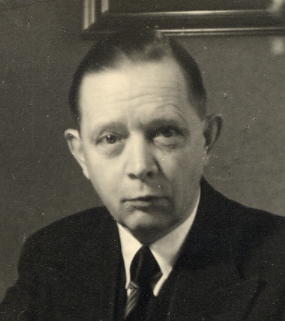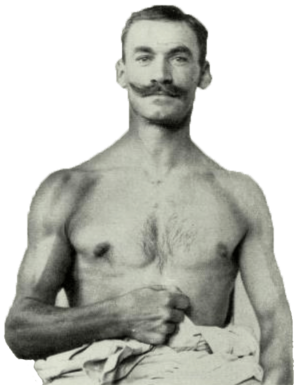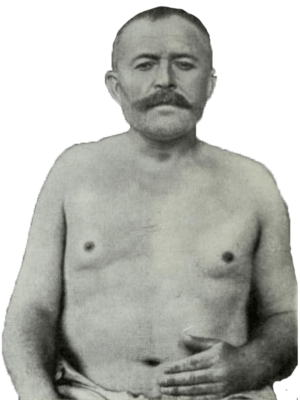Ernst Kretschmer facts for kids
Quick facts for kids
Ernst Kretschmer
|
|
|---|---|

Ernst Kretschmer
|
|
| Born | 8 October 1888 Wüstenrot, German Empire
|
| Died | 8 February 1964 (aged 75) |
| Nationality | German |
| Known for | Typology |
| Scientific career | |
| Fields | Psychiatry |
| Institutions | Marburg University |
Ernst Kretschmer (born October 8, 1888 – died February 8, 1964) was a German psychiatrist. He studied how people's bodies are built and created a system to classify different personality types.
Contents
Life of Ernst Kretschmer
Ernst Kretschmer was born in Wüstenrot, a town near Heilbronn, Germany. He went to school at Cannstatt Gymnasium, a very old Latin school in Stuttgart.
From 1906 to 1912, he studied many subjects. He learned about theology (the study of religion), medicine, and philosophy. He studied at universities in Tübingen, Munich, and Hamburg.
In 1913, he became an assistant to Robert Gaupp in Tübingen. He earned his habilitation there in 1918. This meant he was qualified to teach at a university. He worked as an assistant medical director until 1926.
In 1926, Kretschmer became the head of the psychiatric clinic at Marburg University.
He helped start the International General Medical Society for Psychotherapy (AÄGP) in 1927. He was the president of this group starting in 1929. In 1933, he left the AÄGP because of political reasons. After this, he supported the SS and signed a pledge of loyalty to Adolf Hitler and the Nazi state.
From 1946 to 1959, Kretschmer led the psychiatric clinic at the University of Tübingen. He passed away in Tübingen when he was 75 years old.
Kretschmer's Scientific Ideas
Understanding Brain Conditions
Kretschmer was the first to describe a condition called the persistent vegetative state. This condition is sometimes called Kretschmer's syndrome. He also named a type of paranoia called Kretschmer's sensitive paranoia. This helped doctors understand a type of paranoia that was not known before.
Between 1915 and 1921, he also worked on telling the difference between schizophrenia and manic depression.
How Body Types Affect Personality
Kretschmer is well-known for creating a system to classify people based on their body-types. He developed this idea in the early 1900s. He believed that a person's body shape could be linked to their personality.
He described four main body types:
- a) Asthenic: People who are thin, small, and weak.
- b) Athletic: People who are muscular and have large bones.
- c) Pyknic: People who are stocky and have more body fat.
- d) Dysplastic: People whose bodies are not well-proportioned.
Another scientist, Emil Kraepelin, had already described two main types of mental illness: manic-depressive illness (now called bipolar disorder) and dementia praecox (now called schizophrenia).
Kretschmer thought that each body type might be linked to certain personality traits. He also believed they could be linked to different mental disorders. For example, he thought there was a weak link between schizophrenia and the pyknic body type. He also thought there was a link between people with manic-depressive psychosis and asthenic, athletic, or dysplastic body types.
He believed that pyknic people were often friendly and liked being with others. If these traits were very strong, he thought it might mean they were more likely to have manic-depressive illness. He linked thin people to being introverted and shy. He saw this as a milder form of the symptoms seen in people with schizophrenia who withdraw from others.
However, it's important to know that the idea of linking body types to personality traits is no longer used in modern personality psychology.
Asthenic Body Type
Kretschmer described the asthenic type as someone who is "thin and not very wide." This thinness is seen in all parts of the body. This includes their muscles, bones, neck, face, and limbs. Their average weight and other body measurements are usually below average.
An asthenic man would be lean and narrow. He would have narrow shoulders, thin muscles, and a narrow, flat chest. You might even see his ribs.
Asthenic women are also thin and often shorter than average. They generally look similar to asthenic men.
| Average Measurements for Asthenic Type | ||
|---|---|---|
| Men | Women | |
| Height (cm) | 168.4 | 153.8 |
| Weight (kg) | 50.5 | 32.8 |
| Width of
shoulders (cm) |
35.5 | 44.4 |
| Chest (cm) | 84.1 | 77.7 |
| Stomach (cm) | 74.1 | 67.7 |
| Hips (cm) | 84.7 | 82.2 |
| Forearm
(circum.; cm) |
23.5 | 20.4 |
| Hand
(circum.; cm) |
19.7 | 18.0 |
| Calf
(circum.; cm) |
З0.0 | 27.7 |
| Length of leg | 89.4 | 79.2 |
Athletic Body Type
Kretschmer's athletic type is known for having very strong muscles, skeleton, and skin.
Typically, an athletic man is medium to tall in height. He has a strong chest and wide, noticeable shoulders. He also has a firm stomach and strong legs. The term "hypertrophied shoulders" means their shoulders are very well-developed, not that there is a problem.
Athletic women generally look similar to athletic men. They tend to have more fat than asthenic types, but it's evenly spread. Some athletic women have very noticeable muscles in their bodies and faces. Many athletic women can appear quite muscular.
| Average Measurements for Athletic Type | ||
|---|---|---|
| Men | Women | |
| Height (cm) | 170.0 | 163.1 |
| Weight (kg) | 62.9 | 61.7 |
| Width of
shoulders (cm) |
39.1 | 37.4 |
| Chest (cm) | 91.7 | 86.0 |
| Stomach (cm) | 79.6 | 95.8 |
| Forearm
(circum.; cm) |
91.5 | 24.2 |
| Hand
(circum.; cm) |
21.7 | 20.0 |
| Calf
(circum.; cm) |
33.1 | 31.7 |
| Length of leg | 90.9 | 85.0 |
Pyknic Body Type
Kretschmer's pyknic type is known for having larger body cavities. These include the chest, head, and stomach. They also tend to have fat around their torso. Their limbs and shoulders are often more delicately built.
People who are clearly pyknic have a rounded shape and are of medium height. They have a soft, broad face on a short, strong neck that sits between their shoulders. Their shoulders are not very wide. Their limbs are soft, rounded, and don't show much muscle. Their hands are soft, wide, and short.
Pyknic people tend to have a layer of fat. This obesity is usually moderate. For female pyknics, the fat tends to be more concentrated around their hips and chest.
The chest-to-shoulder ratio for female pyknics is similar to that of male pyknics.
| Average Measurements for Pyknic Type | ||
|---|---|---|
| Men | Women | |
| Height (cm) | 167.8 | 156.5 |
| Weight (kg) | 68.0 | 56.3 |
| Width of
shoulders (cm) |
36.9 | 34.3 |
| Chest (cm) | 94.5 | 86.0 |
| Stomach (cm) | 88.8 | 78.7 |
| Hips (cm) | 92.0 | 94.2 |
| Forearm
(circum.; cm) |
25.5 | 22.4 |
| Hand
(circum.; cm) |
20.7 | 18.6 |
| Calf
(circum.; cm) |
33.2 | 31.2 |
| Length of leg | 87.4 | 80.5 |
Body Types and Mental Health
Kretschmer also looked at how common each body type was among people with schizophrenia and those with bipolar disorder (called 'circular' insanity back then).
| Body Types and Mental Dispositions | |||||||
|---|---|---|---|---|---|---|---|
| Circular | Schizophrenics | ||||||
| Asthenic | • | • | • | • | • | 4 | 81 |
| Athletic | • | • | • | • | • | 3 | 31 |
| Asthenico–athletic mixed | • | • | • | • | • | 2 | 11 |
| Pyknic | • | • | • | • | • | 58 | 2 |
| Pyknic mixture | • | • | • | • | • | 14 | 3 |
| Dysplastic | • | • | • | • | • | — | 34 |
| Deformed and uncataloguable forms | • | • | • | • | • | 4 | 13 |
| Total | 85 | 175 | |||||
Understanding Temperaments
Kretschmer also divided temperaments (a person's nature) into two groups:
- Schizothymic: These people have a mix of being very sensitive and being cold. Their feelings and thoughts can change. Their movements might seem stiff or held back. Schizothymic people are often athletic, asthenic, or dysplastic body types.
- Cyclothymes: These people have a mix of being happy and sad. Their feelings change easily and naturally. Their movements are usually normal and fit the situation. Cyclothymes are often pyknic body types.
The modern name for a milder version of 'circular' insanity is cyclothymia.
Schizoids, a type of schizothymic, can be either hyperæsthetic (very sensitive) or anæsthetic (cold and less sensitive).
Books and Works
Here are some of the books and papers Ernst Kretschmer wrote:
- Wahnbildung und manisch-depressiver Symptomenkomplexe, Berlin, (1914, his first major paper) (about how delusions form and manic-depressive symptoms)
- Der sensitive Beziehungswahn, Berlin (1918), 2nd edition Berlin (1927), (about sensitive relative delusions)
- Physique and Character (International Library of Psychology) (1931), Routledge, ISBN: 0-415-21060-7
- Medizinische Psychologie, (1922) (medical psychology)
- Hysteria, Reflex, and Instinct, Leipzig (1923) Greenwood, ISBN: 0-8371-5754-4
- Die Veranlagung zu seelischen Störungen, with Ferdinand Adalbert Kehrer (1883–1966), Berlin (1924) (about the tendency for mental disturbances)
- Störungen des Gefühlslebens, Temperamente, Handbuch der Geisteskrankheiten. Band 1. Berlin (1928) (about emotional disturbances and temperaments)
- The Psychology of Men of Genius (International Library of Psychology), Berlin (1929), Routledge, ISBN: 0-415-21061-5
- Das apallische Syndrom, in Ztschr. Neurol. Psychiat, 169,576-579 (1940) (about the apallic syndrome)
- Psychotherapeuthische Studien, Stuttgart (1949) (studies on psychotherapy)
- Robert Gaupp zum Gedächtnis, Deutsche medizinische Wochenschrift, Stuttgart (1953) 78: 1713. (in memory of Robert Gaupp)
- Gestufte Aktivhypnose - Zweigleisige Standardmethode, In: V. E. Frankl, V.v. Gebsattel and J.H. Schultz, Hrsg.: Handbuch der Neurosenlehre und Psychotherapie, Band IV, pp. 130–141. Urban & Schwarzenberg, München-Berlin (1959)
- Gestalten und Gedanken (1963) (characters and thoughts)
See also
 In Spanish: Ernst Kretschmer para niños
In Spanish: Ernst Kretschmer para niños
- Posture (psychology)
- Eugène Minkowski



